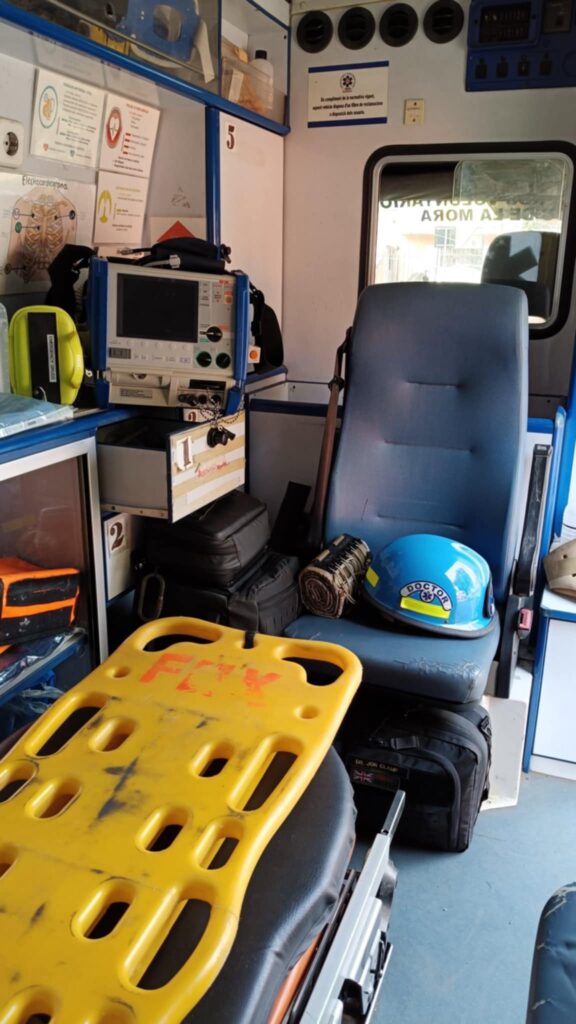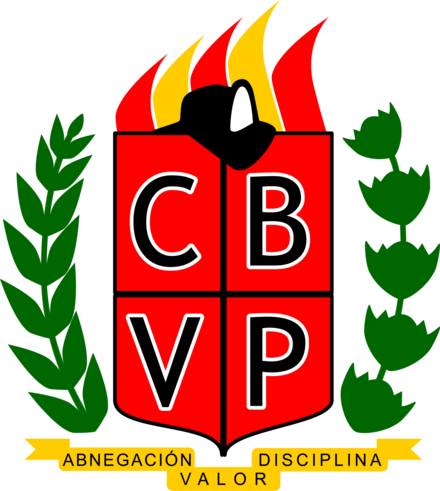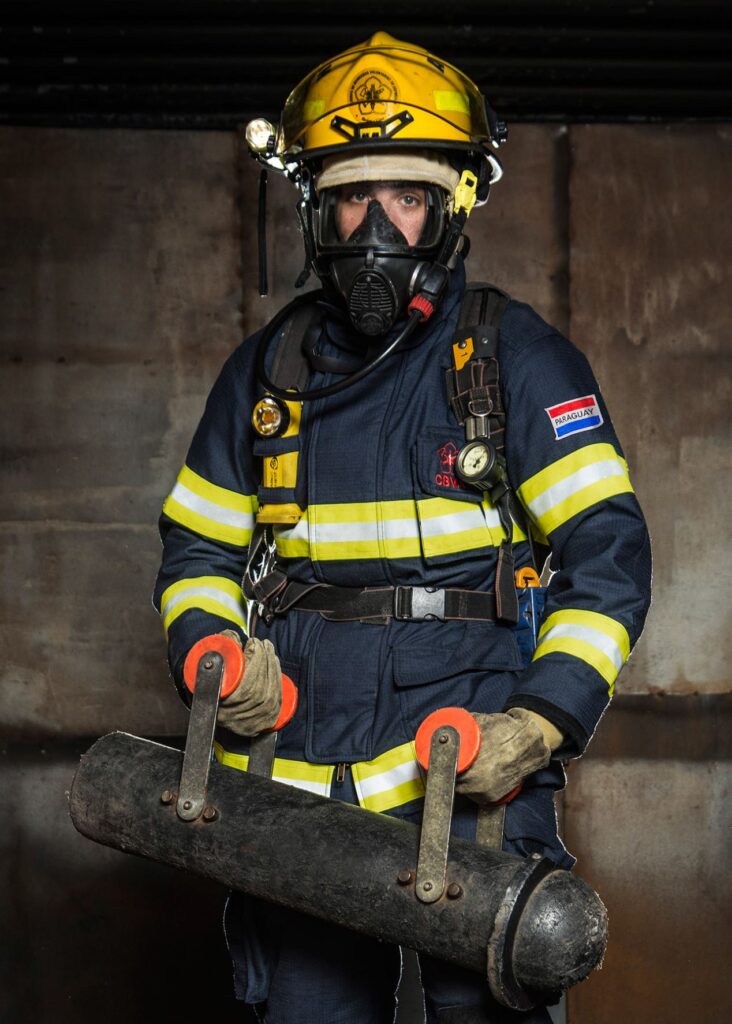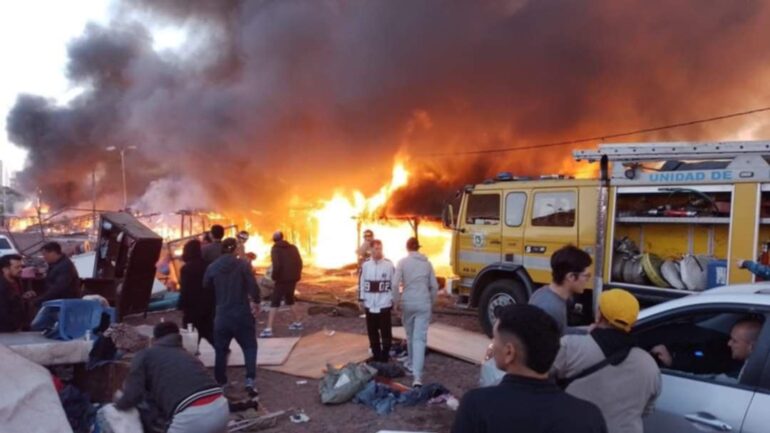My grandfather Denis was a volunteer firefighter in Québec for many years. His area has no big cities, meaning all the firefighters are volunteering and on call. During the summer, I would spend weeks in the region of Lanaudière. It allowed me to see fire at close range, from house to barn fires and bushfires. After moving to Asunción and Paraguay, I was inquisitive about how it worked here. When I was offered the opportunity to write about it, I took my chance and chatted with John, a long-time British expat in Paraguay who is part-owner of Cervecería Aurelia, while being one of the Bomberos – a volunteer firefighter.
Paraguay relies on volunteers to fight fires
Paraguay has different firefighting organisations, which are divided by the colours they wear. The one you see the most is the yellow one, the “original.” The blue one is the second-biggest organisation. You also have the red, the green, and the black, which are not in Asunción but are present in cities around. The green and the black are also present in places like Ciudad del Este.
In Asunción and Paraguay, except for at the airport, all the firefighters, or “Bomberos,” are volunteering. It is not a full-time paid job like in most North American and European countries. For many years, they relied on donations from people and businesses. If you are moving around the town, you still see them wearing their uniforms during a hot day, asking for donations from passersby. They are also still receiving money from enterprises on a monthly basis as a form of security; in any case, other forms of donations are low during a specific month. Not long ago, they only asked for cash, but now, you can pay by bank transfer and receive a receipt. Only recently have the municipalities and the government started giving proper money to their first responders.

The equipment and trucks are donated by foreign entities or governments, such as the United States or the United Kingdom, to name a few. Similar to when Asunción still had a tramway in the city, with wagons donated in parts by Belgium. It depends on the country and the specific donation, but most of the vehicles given are between 15 and 20 years old. It is infrequent that a country or a foreign entity will provide a brand-new truck to Paraguay, preferring to get a new one for themselves and giving the older one to their partner. Some countries helping the Paraguayan Bomberos give equipment around two to three times yearly. He stated that stations recently received a large container of donations from the Netherlands via a charity based there. They have given trucks before, but in the last couple of years, they decided to give more to Ukraine. With the same Dutch charity, they have a partnership which brings firefighters from the Netherlands two times a year to train some Paraguayans here.
As for the money, none is going directly to a Bombero. Currently, the most significant firefighting expense is the maintenance of the vehicles and the equipment. After that, there are administrative costs, personnel training, and day-to-day expenses such as materials used for the first aid kit. If you look strictly at the uniform of a firefighter, for things such as the helmet, the trousers, the jacket, the protective boot, the gloves, and the breathing system, it costs around five thousand dollars per person. John stated that the breathing apparatus was the most expensive part of the equipment, which is indeed an important one, followed by the suit.
The Bomberos: Training as a volunteer firefighter in Paraguay
To prepare for everything that can happen to them, each Bombero has planned training. It is around two times a month, on a Saturday. Some places have exercise sessions on Sundays, but most are on Saturdays. The firefighters can pick the Saturdays they want to do their exercises. It is important for their chiefs that the Bomberos train and be ready for any occasion, no matter the preferred training day. John also said that if a firefighter misses a month, he is removed from the active list. Unless they quit for good, they must redo four months of full training to be reinstated.

At the moment of the interview, a group of Czech firefighters and health workers were in Paraguay to train the locals in nuclear, biological, and chemical hazard incidents. The last two are incidents that unfortunately happen a lot in the country, and the help of foreign countries is greatly appreciated as there was only a little training on that before. One of the biggest that happened with chemical products happened a couple of years ago at an ANDE facility in Fernando de la Mora, where an old electrical box, generally installed on polls, caught fire and spread to all the other boxes stored there. These are full of chemical products, and, at the time, the firefighters were ill-equipped to handle these types of incidents. Recently, most incidents happened in abattoirs or other places taking care of animals and foods, where some giant fridges contained ammonium and were not adequately maintained.
September, October, and November are traditionally the months with the most fire in the Paraguayan Chaco. Some of them are started deliberately and get out of control. For example, the farmers burn their lands and cannot control the fires anymore — a methodology used in other countries 100 to 150 years ago and is still used in Paraguay. Some other things start with litter on the ground, exposure to the sun as there are not many trees, catching fire, and spreading everywhere. The Bomberos are not enough to control everything, and the equipment might not be adapted to the Chaco. In the last few years, Americans have come to help with that, to train people to be ready for fires that might occur in regions such as the Chaco. They have also invested in equipment designed for people controlling forest fires. John said the equipment is useful but insufficient.
As for the training itself, it is well taken indeed. You might have seen on the news recently that a big forest fire broke out at the border of Paraguay and Bolivia. It was so big that there was not enough personnel to control it. They sent people from the capital to the Chaco to control it. Most of those who left Asunción were gone for two weeks. In the meantime, there are fewer of them in the city, which is more at risk, with fewer people covering the territory. Most of the time, even with the influx of personnel from the south, it is still insufficient, and the government asks for help from neighbours like Brazil and Uruguay, as Bolivia and Argentina had a lot on their side to handle as well. The United States also helped a little more than usual to help control the fire.
People interested in joining the firefighter corps need to complete some training before being accepted to ensure they are fit for the job and have time for commitment. The official training is ten months long and takes place on weekends. You cannot miss more than one or two of those weekends. If you miss more, you will not become a firefighter or will have to restart from the beginning at the next session. It might look like a long commitment, but you need to understand how important being a firefighter in Paraguay is. You are not there for the money, but you are there to help people. To be accepted into the training, you need a basic level of education, finished at least high school. You also need a clear criminal record, as you work in collaboration with law enforcement and must be physically fit. As you may know, the firefighter suit and equipment are heavy, and you have it on you sometimes for hours. You need to be able to handle that.
The Bomberos: Types of incidents and response times
As you may know, firefighters do more than extinguish residential and commercial fires. It accounts for only 20% of all the incidents. They are present when needed in a car accident scene, when someone is locked out of a building or a car, when animals are stuck in a tree or the sewage system, or when there are forest fires.
Most fires, no matter which type, are preventable. Some reasons for this are people having economic difficulties illegally connecting to electricity. You might also have seen some big commercial places closing briefly after a specific incident, most often because they needed to follow the city’s or government’s rules and regulations. The biggest fire hazard in older buildings is the piles of paperwork, as they have fewer chances of digitalising their work compared to newer locations, where companies tend to work with newer systems that only need a little use of paper.

There is, however, no specific blame game to do here, as technically, everyone is responsible. We need to be more vigilant. While the older buildings have fewer protective measures against emergencies of any type, with recent laws and regulations changes made a couple of years ago to protect the citizens in case of emergency, newer construction has. For example, the obligation of sprinklers in newly built towers. There have also been implementations made in the last couple of years to teach people fire and safety measures in offices, but they are yet to be implemented on a large scale. A valuable certification is deemed necessary to stay open.
There are fire stations, but in some places, it is only a truck with a designated parking spot. I then asked John what the approximate response time of the firefighter is.
“Response time for firefighters is very good on the haul, but it really depends on where you are and the time of the day. During the day, most firefighters have jobs or are studying, so you might have to wait a little bit longer. At night, the shifts are completed with everybody because people who have finished work and finished their studies. You are guaranteed coverage weekly from 8pm to 6:30, 7 in the morning.”
However, from Monday to Friday during the day, it might not be easy in some areas because there are not enough people to do the work. As they are volunteering, they need to get their money elsewhere, and they have regular jobs. Fire station chiefs are asking their Bomberos to take at least one complete shift every five to six days. Not everyone can do it, but others can do more to compensate. Regarding numbers, if the station is operative, the response time is within two minutes. When they do receive a call, the vehicle is ready to roll.
One problem they have when going to the scene of a car accident with potential victims is that not all the stations have ambulances to go there with them. It is one of the reasons that can delay the response time, as there are route accidents all the time in Asunción and Paraguay without enough ambulances at stations, but also in general. In some cases, the national ambulances can take from forty minutes to an hour to reach the scene of certain accidents. John tragically adds, “In my experience, people have died in front of me while waiting for an ambulance.”
He said that a few are covering the capital area, and only some have the level of paramedics, which does not help, as they have to wait for them to arrive. Sometimes, some come from outside the capital to help. Indeed, it does not always happen, but it is possible. Some stations possess ambulances with the necessary materials and personnel, which help with response times and give victims a chance to survive. Most city and metropolitan area patients are sent to the trauma hospital on Avenida General Santos. For example, if the victim is in the Chaco, they do their best to stabilise the person at the local hospital or clinic and then send it by helicopter to the trauma hospital. The other hospitals only deal with patients who need the minimum care as they do not have the capacity and the necessary materials.
The Bomberos: How you can help
Indeed, being a firefighter is not for everyone. I cannot do what my grandfather was doing for years in Québec. I do not have the strength or the willingness to do so. Here in Paraguay, firefighters are risking their lives, for no pay, to save your or someone else’s life, extinguish a fire in the city or rural area, or evacuate people from a factory with a gas leak. They are heroes. Next time you see one, thank them for their service.
And when you are back home, change the batteries in your smoke detector. Doing this can save lives – not just the lives of yourself, your family, and your neighbours, but also the lives of the Bomberos.
You can also donate to the Bomberos. Donations do not go to the individuals, or towards pay, because there is no pay. Donations are spent on equipment, which makes the volunteer Bomberos more effective, and more safe. You can donate to the Bomberos via this link.
Letting other people know about the Bomberos, and sharing their donation links, is another way you can help. You can connect with and follow the Bomberos on Instagram, Facebook, Twitter, and YouTube.
Finally, if you’ve got what it takes, you can join the Bomberos as a volunteer firefighter. To do this, make contact with your nearest Bombero station. All of your Paraguayan neighbours will know exactly where it is.
Some Fire Stations around Asunción to get you started:
Bomberos Asunción (Blue)
Plaza de las Americas, Mcal Lopez/San Martin. Telephone +595 (0) 21 608 777
K2 Santísima Trinidad (Yellow)
Río Pilcomayo y Tte. 2do Fulgencio Houdin. Telephone +595(0) 21 291 80
K3 Sajonia (Yellow)
Coronel López y Lagerenza Barrio Sajonia. Telephone +595 (0) 21 480 000
K20 Mercado 4 (Yellow)
S Leinton esq Ingavi. Telephone +595 (0) 21 201 201
K5 Lambare (Yellow)
San Marcos. Telephone +595 (0) 21 906 830
K4 Luque (Yellow)
San Martín y Boquerón. Telephone +595 (0) 21 644 275
K6 Mariano Roque Alonso
Yrendague y Ballivian Mariano. Telephone +595 (0) 21 756 001


